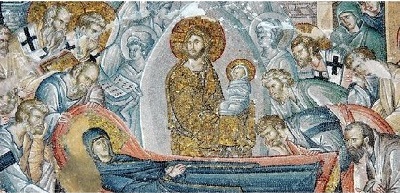Assumption of Mary into heaven
Publish date 19-12-2021
 The solemnity of the Assumption of Mary into heaven celebrates what the apostolic constitution of Pope Pius XII in 1950 defined as a dogma of faith: «The Immaculate Mother of God, always virgin Mary, having finished the course of earthly life, she was assumed to celestial glory in body and soul ".
The solemnity of the Assumption of Mary into heaven celebrates what the apostolic constitution of Pope Pius XII in 1950 defined as a dogma of faith: «The Immaculate Mother of God, always virgin Mary, having finished the course of earthly life, she was assumed to celestial glory in body and soul ".
Was assumed is a passive verb, as if to say that Heaven took her: Christ himself came down to take back his mother, the only creature not only immaculate but who had loved him and shared his life, suffering and obedience. to the will of the Father in a perfect way. Out of pure love, without any kind of personal interest and with total trust in God. She whom the angel of God calls "full of grace" she lived in profound unity with God every moment of her life. Sharing in the love, life and pains of Christ, after her death he also made her a sharer in his glory. With the soul and also with the body. How this happened remains a mystery that we envelop in faith in love for her, true and caring mother, and in gratitude to Jesus who gave us tremendous help and an example to imitate in her. Mary is an example, to be invoked with confidence so that she may guide us on the journey towards Jesus.
In the iconographic tradition we do not find a real icon of the Assumption of Mary; we find the icon representing her death, which in the Orthodox world is translated with the Greek word koimosis, "dormition": the same term that is used in the Gospel to indicate death, understood as a passage.
Jesus in an almond full of angels holds the soul of the Virgin Mother depicted as a newborn in swaddling clothes, and holds it with the same tenderness with which in other icons Mary is depicted with him, as a child, in her arms. A way of telling us that the assumption of Mary was an event that involved the whole of heaven, all the angels and the angelic hosts, who came down together with the Son to "take" dear Mary and bring her into joy (and glory) among his loving arms. This icon therefore depicts the new birth of Mary in heaven and indicates the beginning of her glorious new life. Her body remains stretched out, dead, under the caring and pained eyes of the apostles. To understand this scene we must know that tradition has it that, shortly before Mary died, the Apostles were all far away to proclaim the Gospel, and that, by divine inspiration, they quickly returned to Jerusalem to pay the last homage to the Mother of Jesus, except Thomas. At the moment of death, Jesus Christ descended to take his soul to heaven and afterwards the Apostles in procession carried the body to a tomb near Gethsemane. When the apostle Thomas arrived three days later and wanted to see her body, the tomb was empty.
The bodily assumption of the Mother of God was later confirmed by the message of an angel and her appearance to the apostles themselves, events that recall Christ's death, burial and resurrection by likeness. All wrapped in a very humble silence.
Chiara Dal Corso
NP August / September 2021







